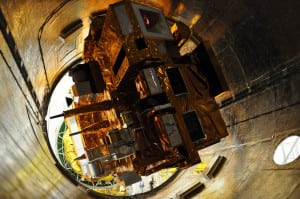Latest News
[Via Satellite 03-14-2016] Company executives at SATELLITE 2016’s satellite manufacturer’s forum “Instant Adaptation to an Instant Culture” emphasized the necessity of cultural change alongside technological changes in order to acclimate to a rapidly evolving market. While new entrants come onto the scene asking for new ideas and time-tested technology on a shorter timeline than ever before, CEOs of satellite manufacturers are also seeing a decline in new orders. In fact, Northern Sky Research (NSR) released numbers that reflected companies had placed just 19 orders for commercial GEO communications satellites in 2015, a steep decline from the 28 orders in 2014 and more of a decline than the industry was forecasting.
NewSpace, New Culture
Manufacturers believe that by pushing a cultural shift they can cope with the changing market as NewSpace and SmallSats flip the industry on its head. These shifts can also help introduce new, affordable tech, such as flexible payloads that can dynamically reallocate capacity in response to changes in demand.
“Some of today’s innovations really come down to culture, what’s in your blood, and how you live and breathe that,” said Mark Spiwak, president of Boeing Satellite Systems International, pointing to new technology such as satellites that have the digital capability to move bandwidth to meet customers’ demands. “As an industry, this is a very exciting time. We are changing, our products are changing, our services are changing, and the expectations of customers are changing. This innovation and instant adaptation is being prepared to meet the demands of the marketplace.”
Paul Etsey, vice president of engineering, manufacturing and test operations at Space Systems Loral (SSL), which is located in the heart of Silicon Valley, Calif., believes that the NewSpace companies are entrenched in a Silicon Valley culture that is based around constant change. SSL has embarked on an initiative to model itself around the speed and innovation present in the culture of Silicon Valley that he feels has not existed in the space industry for many years.
“NewSpace came along and really challenged how we do things,” said Etsey, pointing to culture as the main barrier to pushing new technologies and ideas forward. “We had to change not only what our products were, but how we did things. And what we found over the past couple of years is that it is all about culture — the culture inside our company, the culture of our customers, the culture of our suppliers. In order to change culture, it takes an extreme amount of commitment from the CEO all the way down to the technician on the floor.”
To implement change the company looked to learn from how SmallSat startups are using pre-existing tech as well as bring in younger employees to revamp the “stodgy” space arena.
New Tech
Manufacturers are hoping this change in culture will help push more innovations like the adoption of electric propulsion, which panelists agreed would be built into an estimated 75 percent of spacecraft by 2020. Large satellite manufactures can also look to learn from the technology and procurement methods used in SmallSats that NewSpace companies are producing.
“[With OneWeb] we are going to produce between three and four satellites a day. The cycle is very different. Here, there is the matter of the supply chain having the capability in the suppliers to produce the supplies, but there is also the matter of organizing the supply chain. Also, of course, this means the procurement processes and pushing some innovation in the industry of processes. We are learning this in what we are building now … this can help us to foster ideas on how to do things differently with larger satellites in the design side and the testing side,” said Eric Beranger, managing director of space systems programs at Airbus Defense and Space.
Companies are also hoping to inject more standardization in coming spacecraft.
“At Lockheed Martin we are looking to standardize the product line,” said Carl Marchetto, vice president and general manager of Lockheed Martin Space Systems. As the company looked to modernize its A2100 platform it found the offerings were quite diverse and looked to implement a scalable product line.
“Alongside driving down our cycle costs, the uniformity pays off across the entire enterprise and with our supply chain,” said Marchetto, noting that the company is not ready to standardize everything and will hang on to some areas of testing.
Beranger also noted that further standardization could be pushed by the advent of on-orbit reconfigurable satellites.
“It may not be too far away that a satellite with a totally fixed mission will look a little bit outdated,” said Beranger. “If this time arrives then it will allow us to be even more standardized because then you have the same product but you simply program it to a particular mission.”
New Ways Forward
“In terms of culture and community we have seen a community of passion … but these technologies are not only coming from us, our customers or our industry. What is happening is that space is getting more and more popular. It is more used by more people from outside communities,” said Beranger. “Today there are billions of people using satellites and this enlargement of the community accessing usage is driving the explosion of the needs and innovation.”
Beranger believes that 5G, or the capability of delivering connectivity to “anything, anytime, anywhere,” is one of these technologies that end users are progressing toward, which the satellite industry will have to work to accommodate, but that there will be all types of new tech coming to the forefront as customers demand new capabilities and faster times to orbit.
“We can’t be so insular as to just push technology, but, being manufacturers, a lot of our responsibility is to push that edge of innovation of technology development and what is part of the possible,” said Spiwak.
Get the latest Via Satellite news!
Subscribe Now